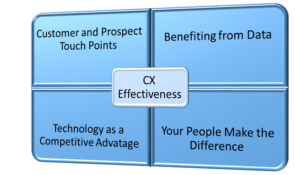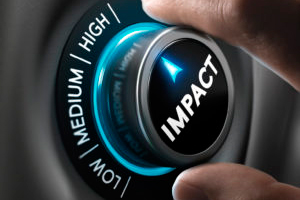50% of top executives see Customer Experience Management and CRM as their #1 investment over the next five years.
What does it mean to have a Customer Experience (CX) Strategy and how does a company execute on that Strategy? What prevents companies from being successful in Customer Experience?
We believe a positive CRM and CX approach begins with understanding the intersection of four significant parts of your business:
- Understanding how your customers and prospects touch your business
- Benefiting from the data within your business with data available outside your business
- Harnessing technology as a competitive advantage
- Your people making the difference

Customer Touch Points
Regardless of the type of business you run, whether you sell to other businesses, Business to Business (B2B), or direct to consumers, Business to Consumer (B2C), or through distribution, Business to Business to Consumer (B2B2C), your customers and prospects interact with your business in many ways. This is sometimes called your Customer’s Journey.
Unless you understand their Journey to and through your business, you run the risk of creating a poor customer experience with them. We can help.
Benefiting from Data
Fingers leave fingerprints. Customers leave digital “fingerprints”. CSI is used to uncover clues in the physical world and Digital Data Analytics, Big Data, and Data Integration is used in the digital world to understand and customize your customer’s journey experience. However, few firms are able to harness the use of this information. [insert quote here regarding the lack of big data results]
Yet, this is the most important area of your business. You run your business on numbers from your accounting department, yet fail to benefit from the data about your customers. We can help.
Technology as a Completive Advantage
Remember the first time you lost your cell phone or thought you lost your cell phone? It was panic.
We live in a digital age. The digital age for businesses started many years ago with computers and accelerated with personal computers and business software for those personal computers. The digital age for consumers started with the commercialized use of the internet and accelerated with the overwhelming success of the Apple’s iPhone. The iPhone success created competition from Google on software and Samsung on hardware. Now, more and more of our interaction with each other and businesses are done through mobile devices.
Technology is like fire. Fire can be used to boil water, cook food, produce heat. It can be destructive as well. Technology can be used to automate business processes, give insight to solve problems, and experiment with to create new products. If not used properly, it too can destroy.
Effective businesses establish various areas that are led by leaders to create focus and efficiency. Thus we have Chief Information Officers for IT, Chief Marketing Officers, Chief Digital Officers, Chief Financial Officers, and Chief Sales Officers to name a few. The speed at which cloud based software is changing how quickly a business can use technology created tension between IT and the business area leaders. In the most extreme cases, some in IT leadership believe that the business leaders in their company do not appreciate nor care about what it takes to implement and support new software and technology. Some business leaders believe that IT is a hindrance to what they have to do to increase revenue or reduce costs. Thus “shadow” IT organizations have developed in some companies to support the business leaders’ requirements for information technology.
Emerging on the scene is roles in companies that bridge the gap between IT and the business leader. The most recent is the Chief Marketing Technologist. It is someone who understands the analytical and methodology required for IT services and the creative nimbleness required for marketing campaigns and customer engagement.
Few companies have this resource. We can help.
Your People Make the Difference
Regardless of knowing the ways your customers’ touch your business, or how you harness the data from within and outside your company, and no matter how you use technology, your people still make the difference.
We install automated call answering and distribution systems to make telephone call processing faster. We use automated email response, Community Forums, and Frequently Asked Question (FAQ) menus for self-driven customer support. Each of these, if done properly, deliver positive results in the number of people served and the quality of overall support. Yet, if someone (a person) is not monitoring these systems, these helpful systems can create a poor Customer Experience.
It is a person who needs to analyze and interpret the data collected. It is a person who must design the marketing campaign. It is a person who documents the journey your customer takes.
All are important tasks. We can help.







